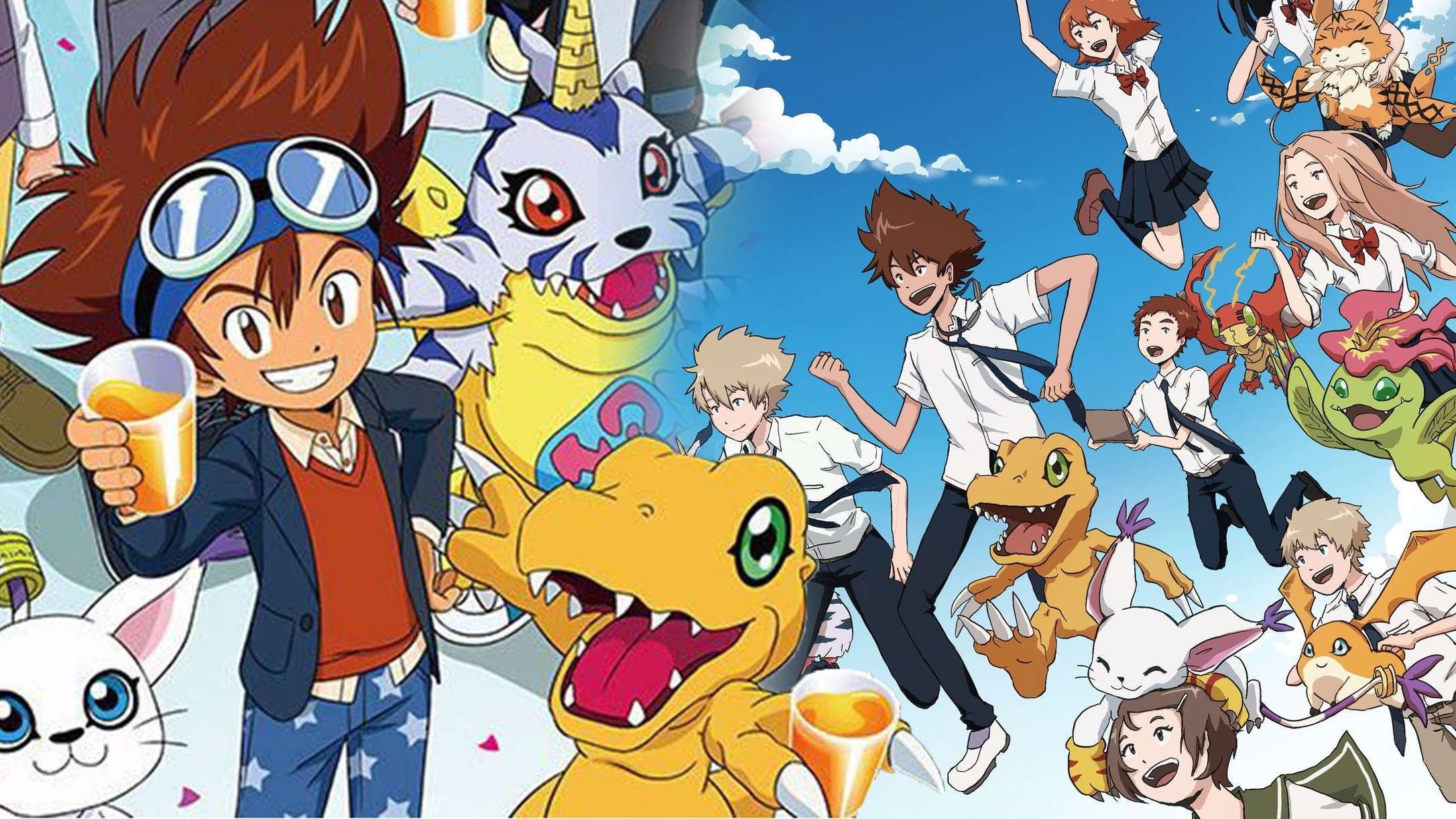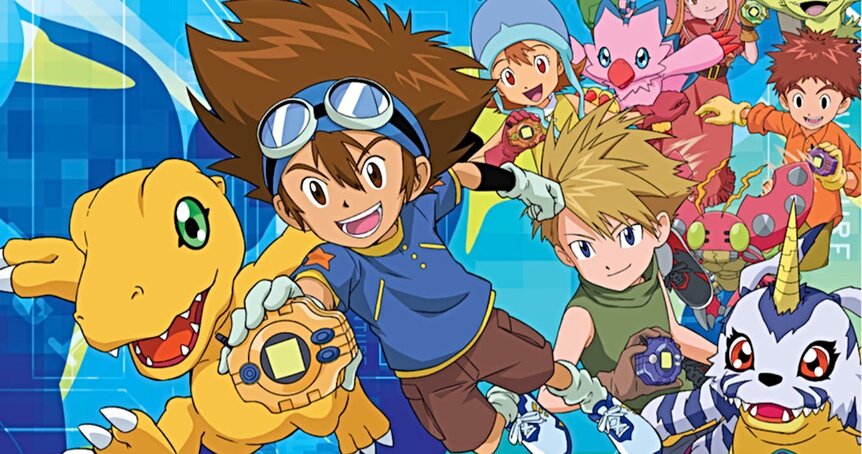Create a free profile to get unlimited access to exclusive videos, sweepstakes, and more!
We came of age with Digimon

When we were kids, Digimon was another in a sea of franchises about monsters trying to sell cards and toys to us. Little did we know, it was so much more than that. It told a story that mattered to us and would speak to us for the rest of our lives. We just didn't realize it at the time.
Digimon first came into existence in 1997 as a spinoff to Bandai’s Tamagotchi targeted to boys who loved battling monsters more than cute animals. The toys rose in popularity over the next few years as more versions of the virtual pet were released alongside a video game, a manga series, and eventually a TV anime series in 1999. That same year, the anime premiered in America on Fox Kids.
This is where our story of Digimon really begins. But this is not the story of Digimon’s toys, video games, manga, or even the anime. This is about Digimon’s fans themselves.
The first part of the story of Digimon and its fans begins with the anime’s premiere in 1999. The series followed seven young kids who went to camp for the summer and wound up living in a digital world. They were each partnered with their own Digimon companions to aid them in the adventure to come. Perhaps more important than the anime, however, was the massive merchandise push that came with it. Saban Entertainment and Bandai America wasted no time licensing the Digimon brand to whoever wanted it. Sure, there were toys. But you could also find Tai and Agumon on your school supplies, coloring books, lunchboxes, even your bedsheets. Digimon wasn’t just our favorite show — it was a lifestyle.
I still remember the first time I saw a brief commercial for Digimon. I immediately thought, “Well, the premise and name of this show sure do sound familiar.” Everyone thought Digimon was just an egregious Pokémon knockoff. Who can blame them? But I’ll never forget the first time I saw Digimon. It was the climax of the second episode. Tai was being attacked by Shellmon and Agumon Digivolved to Greymon to save him. I didn’t even know that this was Digimon yet, and I had missed all of the setup, but I was already invested in this moment. Seeing a little kid nearly dying at the hands of a giant monster and then getting saved by a fire-breathing dinosaur was unlike anything I’d ever seen on a Saturday morning.
Fox Kids viewers all around the world were having similar experiences. My friend and fellow Digimon podcaster Jeff Ruberg sought out the show specifically to get something “like Pokémon” but soon found himself preferring Digimon. “It took a while before it really grew on me,” Ruberg says. “But by the time that Tai and co were fighting to save Tokyo, Ash spinning his wheels in the Orange Islands just became a boring afterthought.
"Pokémon did eventually get exciting again, when Gold/Silver came out and Ash moved on to Johto in October 2000," Ruberg continues. "But by then, I had already ridden a full emotional rollercoaster with Digimon Adventure and was 10+ episodes deep into the Digimon Emperor saga in Adventure 02. The shiny new Johto Pokémon were enticing, but they couldn’t hold a candle to the full narrative arc that I’d already experienced with Adventure, or just how exciting everything in Adventure 02 was shaping up to be. Watching Pokémon felt like treading water, and watching Digimon felt like swimming laps.”
Lots of fans lost touch with the franchise when the third anime series, Tamers, ended and Digimon's home, Fox Kids, vanished forever. You could excuse those fans for drifting away, as the franchise was virtually nonexistent for much of that period. While Disney kept the series alive as best it could, the franchise’s golden age ended at a bittersweet time. Some say the products got worse, but the truth was as plain as day: We were growing up.
I remember being in fifth and sixth grade and thinking I’d grown out of childish things such as Digimon. My friends and I would see ads for new Digimon games in magazines or stumble upon episodes of the newer show while flipping channels. But we didn’t care. We’d moved on. I’d moved on. Many fans I have talked to speak of similar experiences. The anime premieres during their elementary school years and takes over their lives. And just as the franchise starts to change a little bit, they grew up and lost interest.
And then we got pulled back in.
The second part of our coming of age with Digimon took place in high school. It was the mid-2000s, and watching anime illegally on the internet was all the rage. During this period, many of us were rewatching Digimon for the first time since it first aired. And in our older minds, we started to see something else hidden within our favorite childhood Saturday morning cartoon. When I first watched Digimon, I knew that Digimon was short for “Digital Monster” and that they lived in a Digital World, but it wasn’t until I revisited the series that the technological side of Digimon became apparent. Despite being very science fiction, Digimon always felt like a fantasy. As I got older and started to understand concepts like artificial intelligence and virtual reality, I also began to see the real-world possibility behind Digimon.
I also call this period the "sci-fi phase." While Digimon was undoubtedly a science fiction series, a lot of its more advanced concepts probably went over the average viewer’s head. In our adolescence, we started to realize the show was more than just a really, really, really good toy commercial and started picking up on more of those science themes — especially the stuff in the third series.
Rewatching Digimon in high school was an eye-opening experience, but there still wasn’t much of a franchise to keep fans around. Newer anime series and video games made around this time were a nice treat, but they felt off compared to the original adventure we all fell in love with. For many, this second coming of Digimon was a brief chapter and not a full era.
The final — or at least most recent — part of our coming of age with Digimon is the young adult chapter in both our lives and the life of Digimon itself. For many of us, Digimon was simply a kid’s franchise we revisited in our teenage years. But by the time we had completely grown up, so had Digimon.
While some may argue that Digimon is not a kids’ show due to the “dark” and “mature” plots and themes — like Matt and T.K.’s parents being divorced or Tai giving his sister pneumonia — it’s still for kids. It’s still about selling toys and cards. It’s still full of poop jokes.
That started to change during the last decade. After the end of the at-the-time-final TV anime series targeted to kids, a massive shift occurred throughout all Digimon media. The games especially ditched the cartoony aesthetic they’d always had and started to look — and feel — more like a Persona game.
It wasn’t just that the new games were rated T for Teen and ditched the “We can do anything with the power of friendship” attitude from the '90s. This era of Digimon felt more adult because it was actually being made for older fans who grew up with the early franchise.
But the biggest sign that Digimon had grown up with us wasn’t on the PlayStation — it was in theaters. Digimon Adventure tri. was a brand-new anime movie series made for older fans above anyone else. But it wasn’t just a new Digimon story. The new series saw the return of the original characters from the first anime series set during their high school days. Digimon had finally, and truly, grown up with us.
We came of age with Digimon because Digimon is a coming-of-age story.
The Digimon partners in the anime weren’t just cool friends who could transform and fight bad guys. Each character’s story is really about a kid who has a very real problem and a Digimon partner specifically chosen to help them work through those problems. It is no coincidence that a Digimon’s evolutionary stages are named after stages of growth. As the children grow and mature, their Digimon grow and become stronger.
This era also saw a huge spike in online discussion of the franchise. Message boards saw increased membership, older games and toys increased in resale value, and a slew of podcasts popped up to reflect on the series, including Ruberg’s Podigious.
“Watching and discussing the show in a public way completely changed a lot of the ways I’d thought about it,” Ruberg says. “By turning my love for the show into a productive creative outlet, I got over any lingering sense of shame that I had for liking such a childish series. By discussing the show from a feminist perspective and getting backlash from listeners who wished we didn’t have such an 'agenda,' I learned a lot about gender biases and became a more vocal feminist.”
Digimon has always been a big part of Ruberg's life. It was part of what inspired him to get into programming. Today, he is an app developer for Viz Media working in the anime industry that stood at the center of much of his childhood.
As Digimon — both the monsters and the series — evolved, so too did fans' perception of it. When Digimon Adventure first aired, most fans said their favorite character was either Tai or Matt (girls usually said Sora) because they were the cool kids we were supposed to admire. During the sci-fi high school days, many fans recollect identifying more with the computer-brained Izzy stuck behind his laptop. Nowadays, as we’ve all grown up, the most common favorite character I see is Joe, the frailest and weakest member of the cast. For most of the story, he’s an extra meant to fill out the cast and be the butt of jokes. And yet for many of us, he is the one we identify with the most. Joe is the Digi-Destined who, like us, matured and grew up alongside Digimon itself.
As we watch the final adventure of the original Digimon cast and witness the birth of a new generation of Digimon fans as the 2020 reboot begins, I start to wonder if this story is over. Has our own story of coming of age with Digimon reached its end, or is there more to the story? As the average Digimon fan enters their 30s in the coming years, it’s hard to say what will come next. I for one believe that as long as Digimon continues, its fans will continue to grow with it. This is our story, and it’s not over yet.



























